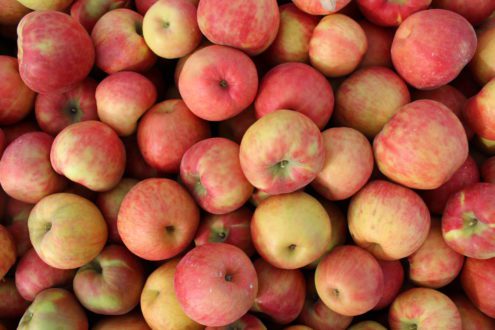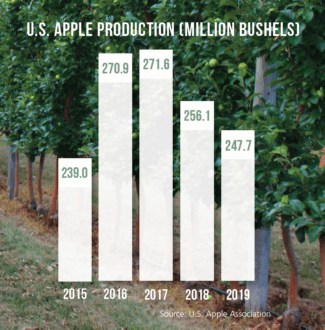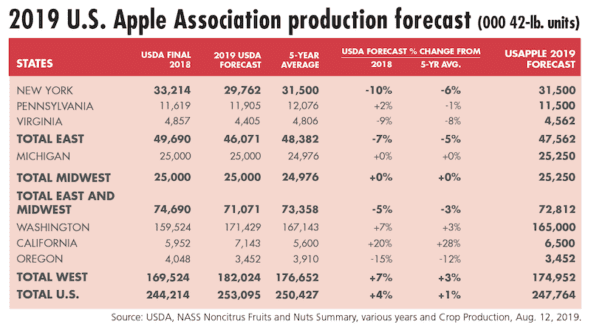

Oct 10, 2019Apple crop forecast follows recent path
The U.S. Apple Association estimate of the size of the 2019 U.S. crop came in at 247.7 million bushels.
The estimate was given during USApple’s annual Crop Outlook and Marketing Conference held Aug. 22-23 in Chicago.
The 2019 estimate represents a 1% increase from 2018’s final crop of 244.2 million bushels, and is 1% below the fiveyear average.
Here’s a regional breakdown:
• In the Eastern states, the 2019 estimate is 47.5 million bushels, down 4% from 49.6 bushels in 2018 and 2% below the five-year average.
• New York will produce 31.5 million bushels, down 5% from last year and equaling the five-year average. Pennsylvania will produce 11.5 million bushels, down 1% from 2018 and down 5% from the five-year average. Virginia will produce 4.5 million bushels, down 6% from 2018 and down 5% from the five-year average.
• The Midwest estimate (based only on Michigan) is 25.2 million bushels, up 1% from 2018’s total of 25 million bushels and 1% above the five-year average.
• In the Western states, the 2019 estimate is 174.9 million bushels, a 3% increase from 2018 and 1% below the five-year average.
Washington, which once again leads the nation in the 2019 forecast, will produce 165 million bushels, up 3% from 2018 but down 1% from the five-year average. California will produce 6.5 million bushels, up 9% from last year and up 14% from the five-year average. Oregon will produce 3.4 million bushels, down 15% from 2018 and down 13% from the five-year average.
International estimates
According to the outlook reports, Mexico will produce 27 million boxes of apples in 2019. Its largest production state, Chihuahua, will supply 23 million of those boxes.
Canada will produce 18.8 million bushels of apples, down 2.3% from 2018 but up 1.9% from the five-year average. Ontario will supply 7.2 million, Quebec 5.3 million, British Columbia 4 million, Nova Scotia 1.9 million and New Brunswick 145,000.
European production is estimated at 10.5 million metric tons, down 20% from the bumper crop of 2018 and down 11% from the five-year average. The decline in production will be led by the largest producer, Poland, which will produce 2.7 million metric tons this year, down 44% from 2018 and down 30% from the five-year average. Italy will produce 2.1 million metric tons, down 3% from 2018 but equaling the five-year average. France will increase production with 1.6 million metric tons, up 12% from 2018 and up 10% from the five-year average.
In South America, Chile will produce 1.6 million metric tons of apples, Brazil will produce 1.1 million metric tons and Argentina 608,000 metric tons.
USDA comparison


Mark Seetin, director, regulatory and industry affairs for USApple, reported USApple has been closer than USDA to the final production total in seven of the last 10 years.
According to an Aug. 12 estimate by USDA, 253.1 million bushels for the 2019 apple crop would be the ninth largest since the government department began reporting apple production in the 1940s, reinforcing the need for access to top apple markets.
“With exports and income down significantly, and a large harvest already beginning, these numbers express the dire need to resolve the trade conflicts as soon as possible,” said USApple President and CEO Jim Bair. “There is not a day to delay.”
Amid growing trade tensions and escalating tariffs from top export countries, the overall farm gate income for U.S. apple growers fell 16%, or $588 million, from 2017 to 2018. The Agriculture Department’s Trade Mitigation Program purchased $83 million of fresh apples according to Agricultural Marketing Service officials.
Honeycrisp moving up
Seetin said the industry continued the trend to adapt to consumer preferences by increasing production of Gala and Honeycrisp, which is expected to overtake production of Granny Smith with the 2019 crop. If the current trend continues into 2020, Seetin said, Honeycrisp could even move ahead of Fuji to third place in overall production. The 2019 top five produced apple varieties, based upon the USDA Aug. 1 estimate, are:
1) Gala.
2) Red Delicious.
3) Fuji.
4) Honeycrisp.
5) Granny Smith.
“Red Delicious, while still an important apple variety, particularly for the export market, continues to lose share to other varieties,” said Seetin. After more than 75 years as the top grown apple in the U.S., Red Delicious was dethroned last year by Gala.


Colombini leads the charge
The U.S. Apple Association has named a new chair to lead its board of directors. Jeff Colombini, a third-generation California grower and tree fruit business owner, will serve the 2019-20 term.
Colombini is president of Lodi Farming, a company that farms 1,800 acres of apples, cherries, olives, and walnuts in the northern San Joaquin Valley. Prior to farming full time, Colombini worked as an operations analyst for Stanislaus Food Products and as a loan officer for the Farm Credit System.


gavel to Jeff Colombini, new chair of the U.S. Apple Association Board of Directors. Photo: USApple
“Jeff ’s significant knowledge of the apple industry, coupled with his business acumen and hands-on leadership, will be a tremendous asset to USApple as he takes on his new role as chair,” said Bair said. “Jeff always goes the extra mile to champion the apple industry, whether it’s by participating in a meeting at the White House or on Capitol Hill, speaking at a press event, or capturing video of himself advocating apple issues for social media. We’re excited for the coming year with Jeff at the helm.”
Colombini has been active in the apple industry for years, including three years of service as a USApple officer. His immediate past role was vice chair of the USApple Board of Directors.
Aside from his leadership with USApple, Colombini serves as chairman of the California Apple Commission and past chair of the California Cherry Advisory Board and the Olive Oil Commission of California. He currently serves as secretary for the Olive Oil Commission and is active in the Linden Lions Club, serving as president from 2012-2013. He is a graduate of the California Agricultural Leadership Program.
Colombini earned a bachelor’s degree in agriculture business management and a technical degree in fruit science from California Polytechnic State University, San Luis Obispo.
Colombini succeeds 2018-2019 chair Kaari Stannard, owner of New York Apple Sales in Glenmont, New York.
— Gary Pullano, managing editor














